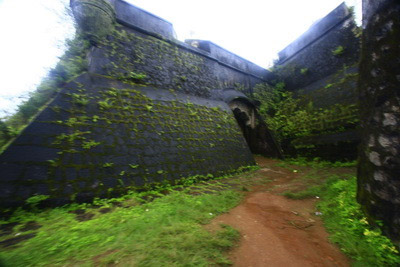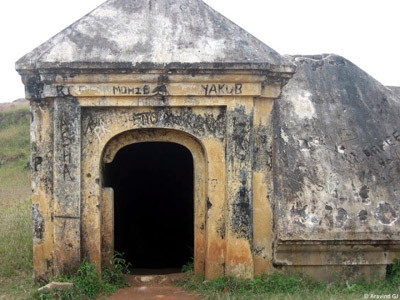 |
Manjarabad Fort
Sakleshpur, India
|
|
 |
Constructed: 1785-1792
Used by:Tipu Sultan, India
Conflicts in which it participated:
Fourth Anglo-Mysore War (1898-1899)
|
At the end of the 18th century, Britain and France, doing their eternal struggle-for-domination-over-the-entire-world thing, were both interested in India, and thus had to do everything in their power to screw with each other.
Tipu Sultan (1750-1799), the squat but effective ruler of Mysore, a sovereign kingdom in southern India, was busily expanding his dominion in the 1780's. This may or may not have bothered the British, but what most definitely did bother them was that the Tipu was being assisted a great deal by the French.
|
 |
|
|
Mysore's fortified capital city was Seringapatam, where the Tipu ruled amongst a glittering panoply of gold, jewels and tigers, many of which were bedecked with both gold and jewels. The Tipu ordered construction of Manjarabad Fort in 1785, atop a mountain that commanded the Mangalore-Bangalore road, which would be the likely avenue of approach for a concerted British attack. The fort was completed in 1792.
It should be noted that the main British entity involved in this region was in fact the British East India Company (BEIC), but their interests seem to have been so similar to and heavily supported by the British Empire that the two seem indistinguishable. At least to me, but what do I know.
|
 "One can reach the fort after walking on a muddy path and climbing a flight of stairs..." "One can reach the fort after walking on a muddy path and climbing a flight of stairs..." |
 |
There is very little information online about the creation of Manjarabad Fort, but it seems likely that the Tipu would have had French engineering support in both its design and construction. An eight-pointed star, the fort was designed more as a watchtower and arsenal than a bristling-with-cannon kind of fort...the more points your fort has, the more difficult it is to effectively mount cannon and mutually support each bastion.
Manjarabad Fort takes up the entire top of its supporting mountain, making it virtually unassailable other than through its main gate. The fort's name reportedly came from the fact that its mountaintop was frequently shrouded |
|
by mist, which is known as manju in Kannada, a language spoken by local residents.
The Tipu and his French-trained army defeated a British force under Lord Cornwallis (1738-1805) in 1791, and Napoleon Bonaparte (1769-1821) made efforts to more directly unify with the Tipu and others fighting the British through an attempted invasion of Egypt in 1798. The Battle of the Nile (August 1-3, 1798) was a decisive defeat for the French Navy, however, and Napoleon's dream of a Tricolored India was foiled. Which left India open for its glorious Union Jack-colored future!
|
The Fourth Anglo-Mysore War (1798-1799) brought an allied BEIC and Indian army of 50,000 to Seringnapatam in 1799 (there's no suggestion that Manjarabad Fort sounded the alarm, or did much of anything, to help the Tipu's situation). The British/Indian force was commanded by General George Harris (1746-1829), and after a siege of nearly a month, the British successfully blasted their way into the fortified city. The Tipu was killed in the defense of his capital, by Private Richard Sharpe of the 33rd Regiment of Foot...at least according to the most excellent book Sharpe's Tiger, written in 1997 by Bernard Cornwell. |
 |
|
|
The British took control of Manjarabad Fort shortly after the fall of Seringapatam, and "destroyed a part of it." One of the fort's enduring legends is that it had a tunnel leading all the way to Seringapatam, which seems awfully unlikely, as the two are at least 50 miles distant from one another. As recently as 2008, one of Manjarabad Fort's guides reportedly told a blogging visitor that there indeed was such a tunnel, and that "a few decades back" some adventurous visitors attempted to make the walk to Seringapatam, only to turn back after half a "kilometer" due to lack of oxygen! How on earth could anyone travel fifty miles in such an environment?
|
 The entrance to a tunnel! The tunnel? Unclear. The entrance to a tunnel! The tunnel? Unclear. |
 |
The only evidence that there may have been a fight at Manjarabad Fort is that the British reportedly filled a tunnel thereunder with bodies, which would assumedly not be their own. Recent visitors report that there are any number of tunnels radiating out from the fort, but that the one the British stuffed bodies into is now closed off after the length of a few steps.
Today, opinions vary as to Manjarabad Fort's suitability as a tourist destination, but the Bangalore-Mangalore Road is a heavily-traveled one, and the fort seems to get plenty of visitors. Some scenes of the vastly popular in India (and vastly unheard-of anywhere else) 2006 movie Mungaru Male were shot at Manjarabad Fort.
|
|
Reportedly, some portions of Manjarabad Fort are currently under reconstruction. Thanks to Aravand GJ, whose blog was by far the most informative source of information and pictures of Manjarabad Fort that I was able to find!
|
|
|
|
|
|
 |




